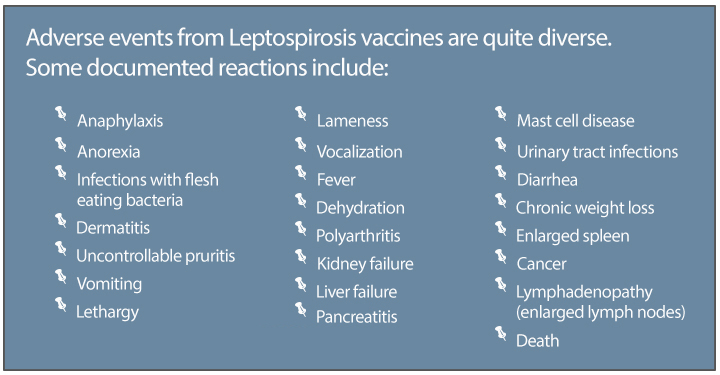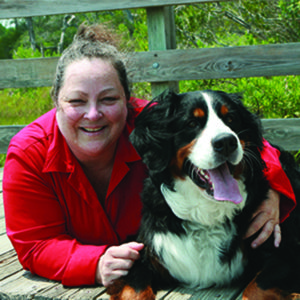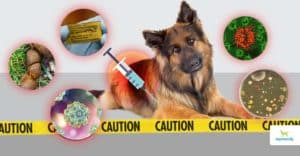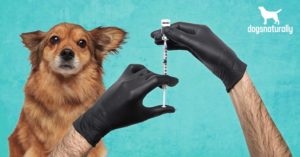Have you had a veterinarian strongly urge you to vaccinate your dog for Leptospirosis? Or perhaps she just offered you one of those vaccine cocktails like DHLPP without really telling you what’s in it? (t contains Distemper, Parvovirus, Hepatitis or Adenovirus, Parainfluenza – and yes, the “L” is Leptospirosis.)
And if you’ve allowed your vet to give your dog the leptospirosis vaccine, you might have been lulled into a false sense of security. So here are some important facts about leptospirosis and the lepto vaccine.
What Is Leptospirosis?
Leptospirosis is an infection caused by Leptospira bacteria. Dogs can catch Leptospira bacteria from water or soil that’s contaminated with infected urine from rodents and other wild animals. If your dog spends a lot of time playing in ponds or lakes or drinking out of puddles or standing water, he may be at risk, depending on the incidence of Leptospirosis in your area.
Many vets are afraid of Leptospirosis, for a couple of reasons. Some of them have seen dogs become very ill with the disease. Others worry because it’s a zoonotic disease, meaning it can be contracted by humans.
Leptospirosis In People
Humans can get Leptospirosis through contact with the urine of an infected animal, but because there are only 100 to 200 cases per year in the US, the CDC does not even consider it a reportable disease. Thirty states do report human cases and the highest prevalence of human infection through Leptospirosis transmission is in Hawaii.
The disease does occur more in tropical climates where there is likelihood of standing water or flooding. Rat infestations in densely populated urban areas are also a factor.
Leptospirosis In Dogs
Leptospirosis in dogs is most commonly found in Hawaii, the west coast (especially California, Oregon and Washington), the upper Midwest, parts of Texas, Colorado and the mid-Atlantic coastal region. Leptospirosis also occurs in the southeastern US.
Within the genus Leptospira there are 20 different species and more than 200 different serovars (a group of closely related microorganisms with a common set of antigens).
In most cases, Leptospirosis in dogs is highly treatable when recognized early. Conventional treatment with antibiotics (typically Doxycycline) usually takes quick effect but aren’t always necessary if you work with a homeopathic vet. Homeopathy is very successful in treating lepto.
However it’s important to note that there is a peracute (very sudden) form of the disease where animals go into rapid shock and die. Very sadly, neither vaccination nor antibiotics will save these cases.
The Leptospirosis Vaccine in Dogs
Despite the risks of Leptospirosis, leading immunologists like Dr Ronald Schultz don’t recommend the Leptospirosis vaccine. Dr Schultz doesn’t vaccinate his own dogs even though he lives in on a farm in a Leptospira endemic area. Infectious disease expert Dr Richard Ford has also stated publicly that despite living in an endemic area, he would not vaccinate his dog. Likewise, Dr Jean Dodds does not advise the use of the Leptospirosis vaccine.
But, as mentioned earlier, many vets are afraid of Leptospirosis. So, depending on who you ask, you’ll find experts who are either for or against the Leptospirosis vaccine. This means it’s a good idea to learn more about Leptospirosis because ultimately, it’s your choice whether or not you vaccinate your dog.
There are many problems with the Leptospirosis vaccine, which is why many vets stay away from it. The two most important strikes against it are …
- It doesn’t provide effective immunization
- It has an extremely high rate of adverse reactions
Ironically, vaccinated animals can also shed the bacteria and infect humans.
The Leptospirosis Vaccine In Dogs Isn’t Effective
Unfortunately, many vets recommending Leptospirosis vaccines rely on information provided by the drug companies that make the vaccines. As a result, they don’t know the vaccine does not provide immunity. A study published in 2015 by Merck researchers recognizes the shortcomings of the current lepto vaccines available:
Killed, whole-cell bacterin vaccines are licensed worldwide and have not changed greatly over the past several decades. Vaccine-induced immunity is restricted to serologically related serovars and is generally short-lived, necessitating annual revaccination. The appearance of new serovars as causes of canine leptospirosis requires constant epidemiological surveillance and tailoring of vaccines to cover emerging serovars. (1)
Another study in 2017 by SF Lau et al at UNiversity Putra Malaysia, looked at the antibodies of working dogs vaccinated for lepto, found only 3% of dogs had positive lepto titers. They commented:
The results revealed that, by vaccination alone, working dogs were not fully protected against leptospirosis and could pose a risk to dog handlers. (2)
There are many cases on record of vaccinated dogs contracting the disease, both in the US and abroad. In the US, several veterinary clinics (one a referral hospital) have informed me of cases of vaccinated dogs still contracting Leptospirosis.
In Hong Kong, it’s common for vaccinated dogs to die from lepto. And the UK organization Canine Health Concern conducted a survey in which many dog owners reported that their vaccinated dogs were still getting lepto.
Leptospira vaccines in dogs also appear to have little effect on transmission of the disease in animal populations.
Vaccines Don’t Cover All Strains Of Lepto
So … either the vaccine doesn’t work, or there are serovars causing the disease that the vaccine doesn’t cover.
Given the high number of lepto serovars and the fact that there are so many strains of the disease that are not covered by the vaccines, the latter seems likely. In the US, serovar shift is the excuse given for the vaccine not working. Theories that the vaccines are responsible for serovar shift in the first place have never been confirmed.
If you even consider vaccinating your dog for Leptospirosis (and I hope you won’t after reading this article), it’s extremely important that you find out every year which serovar is responsible for Leptospirosis infections in your area, using your state’s public health records.
Make sure the vaccine is an exact DNA match for the pathogenic strain your dog will encounter, or else you’ll be subjecting your dog to a great deal of pointless risk. The presence of many more nonpathogenic Leptospira means that finding an exact match with the vaccine can be extremely challenging.
Leptospira vaccines for dogs are now available in two forms:
- The original two-way vaccines contained only the L. canicola and L. icterohaemorrhagiae serovars;
- The more recent four-way vaccines also contain L. grippotyphosa and L. pomona.
The four-way vaccine is the recommended choice because L. canicola and L. icterohaemorrhagieae infections appear to be in decline, while L. grippotyphosa is on the rise. Two additional serovars now identified as causing infection, L. bratislava and L. automnalis, are not included in current vaccines.
It would be extremely expensive to monitor the environment for the presence of specific serovars. Because the disease is scarce in humans, no such program currently exists.
Finally, even if the vaccine is a match for the serovars, any protection it offers is very short lived. Because of this, many vets recommend revaccinating every six months for dogs at high risk, although Dr Schultz has said that in order to have antibody protection you’d have to vaccinate with the four-way vaccine four times a year.
You Can Get Lepto From Your Vaccinated Dog
Once vaccinated, your dog can shed the Leptospira microbes, becoming a source of infection for you and your family.
I know several cases where the canine vaccine was undoubtedly the cause of a human contracting the disease. One such case involved a duck hunter in California. The state failed to find any Leptospira in bodies of water he’d frequented, suggesting it was highly probable he was infected by his vaccinated dog.
Leptospirosis Vaccine Side Effects
Bacterin vaccines like Leptospirosis (and Lyme) are very risky.
One reason experts might be refusing to use them on their own dogs is because the risk of infection isn’t that high. But it’s more likely due to the great number and significance of adverse reactions. Here are some common side effects.
Vaccination Causes Lepto Symptoms
There are documented cases of the antigens for both Leptospira and Lyme disease vaccines creating the same diseases we are trying to prevent with the vaccination. In fact, some dogs vaccinated with Leptospirosis die of renal failure within 48 hours – exactly the same type of pathology that the actual disease can create.
Post-Vaccination Tumors
I have documented several cases of tumors, especially from the “whombo-combo” vaccines that include Leptospirosis. I also see these combinations causing mast cell disease and cytokine storms (an overreaction of the immune system in which too many immune cells are activated in a single place, creating the potential for damage to body tissues and organs).
Autoimmune disease can also result from bacterin vaccination use.
Aluminum Toxicity
A significant additional risk is that the Leptospirosis vaccines all contain aluminum adjuvant. Not surprisingly, aluminum foreign body has been found in tumor biopsies of vaccinated dogs with cancer.

RELATED: Read how the leptospirosis vaccine is causing dogs to die. …
There’s No Lepto Vaccine For Humans
The dangers of the lepto vaccine are apparent in the double standard. While our dogs are given the lepto vaccine, there is no Leptospirosis vaccine licensed for humans in the US. Some of the reasons for this are:
When veterinarians advocate these vaccines, are they aware of the potential for these serious, sometimes fatal adverse events, most of which go unreported? If not, the client is not getting full disclosure. So what does “informed consent” even mean in these instances?
- Unacceptable side effects
- Incomplete and short lived protection
- Increased risk of developing autoimmune disease
- Even if vaccination partially protects, it will not prevent leptospiuria (Leptospira in the urine) so the disease can still be spread in the environment
RELATED: Read this before your give your dog the leptospirosis vaccine …
Signs of Leptospirosis in Dogs
In Leptospirosis, the signs of disease are often vague and nonspecific, and they don’t necessarily correlate to the serovar of infection. There are many different presentations one might find in a dog with a pathogenic strain of Leptospirosis.
If your dog could be exposred to lepto, keep an eye out for some of the early symptoms. Healthy dogs who come in contact with the bacteria may never exhibit symptoms. In affected dogs, these types of symptoms may start to occur within 8 to 10 days after exposure …
- Fever
- Vomiting
- Diarrhea
- Muscle pain
- Blood in the urine
- Lack of appetite
- Lethargy
- Jaundice yellowing of whites of eyes)
Infection results in illness of varying severity, depending on the strain, geographic location and host immune response.Some dogs display mild or no signs of disease, while others develop severe illness or death, often as a result of kidney injury. If you suspect leptospirosis in your dog, ask your vet for help.
Veterinary Diagnosis Of Leptospirosis
In general, veterinarians should suspect Leptospirosis dogs with signs of:
- Kidney or liver failure
- Uveitis
- Pulmonary hemorrhage
- Acute febrile illness
- Abortion
Dogs with acute renal failure may show polyuria (excessive urine production), polydipsia (excessive thirst), dehydration, vomiting, diarrhea, lack of appetite, lethargy, abdominal pain or some combination of these signs. Oliguria or anuria (little or no urine production) and hematuria (blood in the urine) also may occur.
Other symptoms of leptospirosis in dogs resemble indications of liver failure, including jaundice.
Fever occurs early in the course of illness and may be accompanied by shivering, generalized muscle tenderness and reluctance to move.
Other reported lepto symptoms include conjunctivitis, uveitis and acute respiratory distress causing tachypnea, dyspnea or Leptospiral pulmonary hemorrhage syndrome (LPHS), which has been reported most frequently in dogs in some parts of Europe. LPHS appears to have an immune-mediated basis and causes high mortality.
Signs of pancreatitis have been detected in some dogs by abdominal ultrasound.
Meningitis can occur in humans but has not been documented in dogs.
Cardiac damage occurs in human patients and ECG alterations suggesting myocardial damage can occur in dogs.
Miscarriage has also occurred in dogs after spread of the serovar across the placenta.
Note: the peracute form of leptospirosis is deadly. Patients with peracute leptospirosis may exhibit severe symptoms such as rapid breathing and rapid, irregular pulse, coughing up blood, tarry feces, nosebleed and petechial hemorrhage (red or purple spots on the skin). They have be reluctant to move and very sensitive to pain or touch, and have enlarge lymph nodes. Peracute infections usually move so fast that treatment is impossible to deliver in time, Even with intensive care, it’s unlikely the dog can be saved.
How Vets Confirm Leptospirosis Infection
The very wide range of symptoms makes Leptospirosis diagnosis problematic and it can also be difficult to confirm the disease through laboratory testing.
Blood, urine, serum, or other clinical specimens are usually tested. Other diagnostic methods are available including culture, microscopic agglutination test (MAT), immunofluorescence, darkfield microscopy, other serologic tests, and real-time polymerase chain reaction (PCR).
The MAT test is considered the gold standard serologic test to confirm Leptospirosis.
Because it is a difficult test to maintain, CDC is the only laboratory in the United States that offers the MAT for Leptospirosis testing for humans. However, if the patient has been vaccinated, MAT testing is useless. The serum can no longer be a useful record for MAT diagnostic tests because the serum antibody titer from the vaccine is indistinguishable from the antibody caused by natural infection. Multiple serovar vaccines also lead to difficulty in determining which serovar is the serovar of infectivity.
PCR Test. Due to molecular mimicry with antigens, the identification of disease presence is complicated by cross reactivity with other different disease organisms such as syphilis, Lyme, Legionnaires, HIV and autoimmune disease. PCR testing is therefore the preferred diagnostic method. It’s offered by Oregon State Veterinary Diagnostic Laboratory and IDEXX Laboratories.It is considered just as sensitive and specific as culture but significantly faster and more reliable. It has an obvious advantage over serology in the early stages of infection, before antibodies have yet developed.
It is also useful in dogs where MAT testing has yielded negative results but Leptospirosis is still suspected. However, PCR testing must be done before any treatment is given. Just one dose of Doxycycline or another antibiotic will convert a PCR positive to a negative, even in the face of renal failure.
Culture to isolate leptospires from a clinical specimen is confirmatory, but lacks sensitivity and specificity, as some pathogenic and non-pathogenic strains fall into the same serovar, and growth may be slow.
Immunofluorescence is a useful diagnostic measure when performed as immuno-histochemistry for antigen detection in tissues; however, it is typically performed on tissues obtained after death.
Darkfield microscopy is timelier relative to the stage of disease, but lacks sensitivity and specificity.
Is Your Dog At Risk for Leptospirosis?
Consider these factors when you’re assessing your dog’s lepto risk.
- Is Leptospirosis endemic in the places your dog frequents? You can research this through your local public health department. Your vet also should also know the incidence of Leptospirosis infection in your area.
- Climate. Leptospirosis in dogs is most likely to occur in a warm moist environment, during rainy seasons in temperate climates and in tropical and subtropical climates.
- Environment. The organism survives better in stagnant water rather than flowing, and can live 180 days in wet soil or marshy areas, and longer in standing water.
- Exposure. Transmission is most common through direct contact with infected urine or indirectly through vegetation, soil, food, water or bedding contaminated with infected urine. Dense animal population in kennels and urban settings increases the chance of exposure to infected urine. Exposure to rodents and other wildlife is an additional risk factor.
Dogs at risk of contracting Leptospirosis are usually outdoor animals or hunting dogs.
RELATED: Understand your dog’s risk of getting lepto …
Natural Leptospirosis Prevention
Because of its lack of efficacy and the very great risk of adverse reactions, Leptospirosis vaccination is not the answer. In truth, the germ is not the problem: a healthy immune system is the key factor in your dog’s ability to resist disease.
- The foundation of a strong immune system is in the gut, so start by giving your dog the best nutrition you can, preferably in the form of a species appropriate raw diet.
- Minimizing the use of vaccines, pharmaceuticals and other chemicals and toxins, such as cleaning products, fertilizers, etc., in his environment will also contribute to more robust immunity.
- You can minimize your dog’s exposure to the disease by limiting his access to marshy or heavily irrigated areas, ponds and any stagnant surface water.
- Also limit his contact with wildlife, including rodents and other animals in urban areas. If you feel your dog is at very high risk, you may want to consult a homeopath about protecting him with homeopathic nosodes. In Cuba, human exposure to Leptospirosis in post-hurricane flooding in 2007 was very successfully handled by nosodes, with 2.3 million people safely immunized at a small fraction of the cost of vaccination.
RELATED: Learn 5 big steps you can take to improve your dog’s health …
If you’re still tempted to risk vaccinating your dog despite what you’ve read here, remember that in all but the peracute cases, Leptospirosis is highly treatable, and the vaccine doesn’t prevent peracute cases anyway.
Whether you choose conventional treatment with antibiotics or take a holistic approach in consultation with a veterinary homeopath, familiarize yourself with the key symptoms so that you can act quickly to seek treatment for your dog.
References
- Eric Klaasen HL, Adler B. Recent advances in canine leptospirosis: focus on vaccine development. Vet Med (Auckl). 2015;6:245-260. Published 2015 Jun 19. doi:10.2147/VMRR.S59521
- SF Lau et al. Seroprevalence of Leptospirosis in Working Dogs. Topics in Companion Animal Medicine, Volume 32, Issue 4, 2017.















